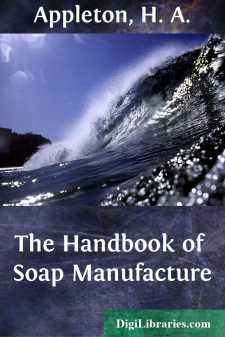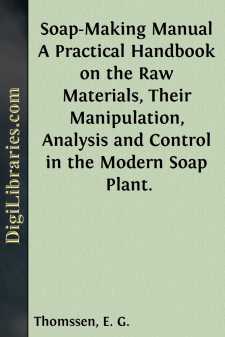Categories
- Antiques & Collectibles 13
- Architecture 36
- Art 48
- Bibles 22
- Biography & Autobiography 813
- Body, Mind & Spirit 142
- Business & Economics 28
- Children's Books 17
- Children's Fiction 14
- Computers 4
- Cooking 94
- Crafts & Hobbies 4
- Drama 346
- Education 46
- Family & Relationships 57
- Fiction 11829
- Games 19
- Gardening 17
- Health & Fitness 34
- History 1377
- House & Home 1
- Humor 147
- Juvenile Fiction 1873
- Juvenile Nonfiction 202
- Language Arts & Disciplines 88
- Law 16
- Literary Collections 686
- Literary Criticism 179
- Mathematics 13
- Medical 41
- Music 40
- Nature 179
- Non-Classifiable 1768
- Performing Arts 7
- Periodicals 1453
- Philosophy 64
- Photography 2
- Poetry 896
- Political Science 203
- Psychology 42
- Reference 154
- Religion 513
- Science 126
- Self-Help 84
- Social Science 81
- Sports & Recreation 34
- Study Aids 3
- Technology & Engineering 59
- Transportation 23
- Travel 463
- True Crime 29
The Handbook of Soap Manufacture
by: H. A. Appleton
Categories:
Description:
Excerpt
INTRODUCTION.
Definition of Soap—Properties—Hydrolysis—Detergent Action.
It has been said that the use of soap is a gauge of the civilisation of a nation, but though this may perhaps be in a great measure correct at the present day, the use of soap has not always been co-existent with civilisation, for according to Pliny (Nat. Hist., xxviii., 12, 51) soap was first introduced into Rome from Germany, having been discovered by the Gauls, who used the product obtained by mixing goats' tallow and beech ash for giving a bright hue to the hair. In West Central Africa, moreover, the natives, especially the Fanti race, have been accustomed to wash themselves with soap prepared by mixing crude palm oil and water with the ashes of banana and plantain skins. The manufacture of soap seems to have flourished during the eighth century in Italy and Spain, and was introduced into France some five hundred years later, when factories were established at Marseilles for the manufacture of olive-oil soap. Soap does not appear to have been made in England until the fourteenth century, and the first record of soap manufacture in London is in 1524. From this time till the beginning of the nineteenth century the manufacture of soap developed very slowly, being essentially carried on by rule-of-thumb methods, but the classic researches of Chevreul on the constitution of fats at once placed the industry upon a scientific basis, and stimulated by Leblanc's discovery of a process for the commercial manufacture of caustic soda from common salt, the production of soap has advanced by leaps and bounds until it is now one of the most important of British industries.
Definition of Soap.—The word soap (Latin sapo, which is cognate with Latin sebum, tallow) appears to have been originally applied to the product obtained by treating tallow with ashes. In its strictly chemical sense it refers to combinations of fatty acids with metallic bases, a definition which includes not only sodium stearate, oleate and palmitate, which form the bulk of the soaps of commerce, but also the linoleates of lead, manganese, etc., used as driers, and various pharmaceutical preparations, e.g., mercury oleate (Hydrargyri oleatum), zinc oleate and lead plaster, together with a number of other metallic salts of fatty acids. Technically speaking, however, the meaning of the term soap is considerably restricted, being generally limited to the combinations of fatty acids and alkalies, obtained by treating various animal or vegetable fatty matters, or the fatty acids derived therefrom, with soda or potash, the former giving hard soaps, the latter soft soaps.
The use of ammonia as an alkali for soap-making purposes has often been attempted, but owing to the ease with which the resultant soap is decomposed, it can scarcely be looked upon as a product of much commercial value.
H. Jackson has, however, recently patented (Eng. Pat. 6,712, 1906) the use of ammonium oleate for laundry work. This detergent is prepared in the wash-tub at the time of use, and it is claimed that goods are cleansed by merely immersing them in this solution for a short time and rinsing in fresh water....












